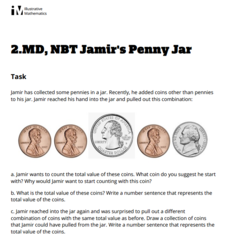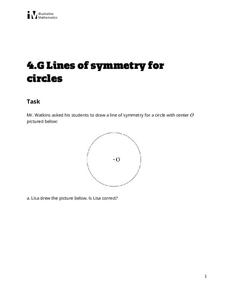Illustrative Mathematics
Fraction Equivalence
Why is six-tenths equivalent to sixty-hundredths? This is the question learners are tasked to explain in writing as well as with a picture.
Illustrative Mathematics
One, Ten, and One Hundred More and Less
What's 1 more or less than a number? What's 10 more or 10 less than a given number? What's 100 more or 100 less than a number? These are the types of problems learners must answer in a six-question worksheet.
Illustrative Mathematics
What's the Point?
Given a certain amount of points, how many line segments can you connect between them? How many close geometric figures can you create? These are the types of questions learners are asked to solve in a assessment-based learning exercise.
Illustrative Mathematics
Saving Money 2
Adding money is a key skill in life. Give a worksheet that requires second graders to find the total amount of money Louis needs to make certain school supply purchases.
Illustrative Mathematics
Regrouping
What number does 6 tens and 16 ones represent? How is it different from or similar to the number that 7 tens and 6 ones represent? This is the type of questions learners are asked to solve as a way to understand the concept of regrouping.
Illustrative Mathematics
Red and Blue Tiles
Here, second graders are tasked to find the patterns that have an even number of tiles. They are asked to think about why these patterns are even or odd and explain how they know.
Illustrative Mathematics
Comparing Sums of Unit Fractions
First, add each set of fractions with unlike denominators. Then, compare their sums with the symbols <, >, or =.
Illustrative Mathematics
Largest Number Game
Learners are asked to make the largest three-digit number they can with the numbers 1, 8, and 5 in a quick assessment worksheet.
Illustrative Mathematics
Digits 2-5-7
Given three digits, what is the largest humber you can make? What is the smallest number you can make? These are the questions second graders are prompted to answer in a three-question quiz.
Illustrative Mathematics
Bundling and Unbundling
Seven tens, plus five ones, equals 75. Five ones, plus seven tens, also equals 75. These are the types of equations learners are asked to make true in a worksheet with 11 unfinished equations.
Illustrative Mathematics
Where Do I Go?
Practice sequencing numbers 1–100 in a card sequencing activity. The hands-on learning makes a short activity flexible and fun. The opportunities are endless and easy to implement.
Illustrative Mathematics
Jamir's Penny Jar
Before you start counting the coins in Jamir's coin jar, figure out which coin to start with. Should it be the penny or the quarter? Why? This is the focus around a learning exercise that works well as an assessment on counting money and...
Illustrative Mathematics
Daisies in Vases
Have your first graders master word problems with an activity that prompts them to find as many combinations for daisies in vases, with the most in the large vase and the least in the small vase. Pupils must also explain their reasoning...
Illustrative Mathematics
Ordering Time
Practice telling time to the nearest five minutes in a digital and analog clock activity. Learners are prompted to order clock cards in increasing time order, and then write the time each clock represents.
Illustrative Mathematics
Sharing Markers
Let your first graders translate these word problems into subtraction sentences. Some of the equations involve finding the answer after Char gives some of her markers away, while others require finding the amount of markers Char started...
Illustrative Mathematics
Lines of Symmetry for Circles
Further your instruction on geometrical symmetry with an investigation of circles. Fourth graders come to realize that the lines of symmetry of a circle are infinite.
Illustrative Mathematics
Which Pictures Represent One Half?
Which image represents one half? Answer the question surrounding four shapes, some of which represent one half and others representing a different amount. The last two questions ask learners to explain why some shapes represent one half...
Illustrative Mathematics
Representing Half of a Rectangle
Did you know one half of a rectangle be represented in more than one way? Young mathematicians choose the rectangles that represents one half with an instructive worksheet.
Illustrative Mathematics
Maria’s Marbles
Ali has more marbles than Maria in some of these word problems, while in others Maria has more marbles than Ali. First graders are tasked to read each word problem and solve how many marbles each girl has.
Illustrative Mathematics
How Many Tenths and Hundredths?
Four hundredths + one tenth = 14 hundredths. Learners complete place order equations in order to make each equation true. Hundredth and tenths are the focus of the worksheet.
Illustrative Mathematics
Comparing Money Raised
How much money did Helen, Sandra, Nita, Luis, and Anthony raise? Compare their amounts with a task that asks learners to answer questions like how many times as much?
Illustrative Mathematics
School Supplies
First graders are tasked to find the amount of money in dollars Pia came to the store with, after she bought five dollars worth of school supplies.
Illustrative Mathematics
Counting Dots in Arrays
Mathematical arrays can represent several different math skills, including counting groups, multiplication, and even area. In this specific task, learners are asked to identify the addition equations that are equal to a 3 x 4 array....
Illustrative Mathematics
Valid Equalities?
True or false: 20 = 10 + 10. The statement is true because two 10s make a 20. These are the types of equations learners must label or false. They must also explain in mathematical terms how they know.

























